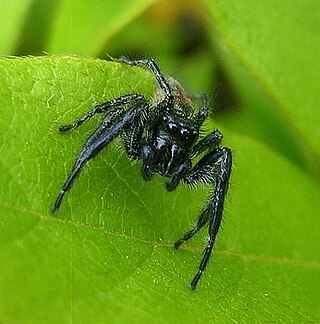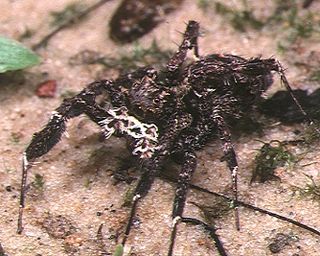
Attulus is a genus of jumping spiders that was first described by Eugène Louis Simon in 1889. The name is a diminutive form of a common prefix for salticid genera, -attus.

Carrhotus is a genus of jumping spiders that was first described by Tamerlan Thorell in 1891. The name is derived from the Greek Κάῤῥωτος.

Evarcha is a genus of spiders in the family Salticidae with 85 species distributed across the world.

Heliophanus is a genus of the spider family Salticidae. Most of the almost 170 described species occur in Africa, with many others found in the Palearctic region from Europe to Japan.

Hyllus is a genus of the spider family Salticidae. Most species occur in Africa and Madagascar, with many in Australasia and north to India. H. insularis is found in Greece and Iran, but it is considered misplaced in this genus, and is now Evarcha insularis.

Langona is a genus of spiders in the family Salticidae. Langona species are similar to those of the genus Aelurillus. In 2015, it was listed in the subtribe Aelurillina. The subtribe is allocated to the tribe Aelurillini in the clade Saltafresia. In 2017, it was grouped with nine other genera of jumping spiders under the name Aelurillines.

Pellenes is a genus of jumping spiders that was first described by Eugène Louis Simon in 1876. It is considered a senior synonym of Hyllothyene.

Plexippus is a genus of jumping spiders that was first described by Carl Ludwig Koch in 1846. It is considered a senior synonym of Hissarinus and Apamamia.

Rhene is a spider genus of the family Salticidae.

Stenaelurillus is a genus of jumping spiders that was first described by Eugène Louis Simon in 1886. Most species live in Africa, with some species found in Asia, including China. All species have two white longitudinal stripes on the carapace, and both sexes show strong bristles around the eyes. The name is a combination of the Greek sten- "narrow" and the salticid genus Aelurillus.

Thyene is a genus of jumping spiders that was first described by Eugène Louis Simon in 1885. It is a junior synonym of Mithion, and senior synonym of Brancus, Paramodunda and Gangus.

Zenodorus is a genus of the jumping spiders distributed from the Moluccas to Australia, including several islands of the Pacific. It was once considered a junior synonym of Omoedus, but this was later rejected by Jerzy Prószyński in 2017. At least one species, Z. orbiculatus, specializes on hunting ants.

The Dendryphantina are a subtribe of jumping spiders that occur mainly in the New World. The subtribe was first defined by Anton Menge in 1879 as Dendryphantidae. Females of the subtribe generally show paired spots on the abdomen, and the males often have enlarged chelicerae. Females in this subtribe typically have S-shaped epigynal openings.

The Spartaeinae are a subfamily of the spider family Salticidae. The subfamily was established by Fred R. Wanless in 1984 to include the groups Boetheae, Cocaleae, Lineae, Codeteae and Cyrbeae, which in turn were defined by Eugène Simon.

Euophryini is a tribe of jumping spiders. Most spiders in this tribe have a spiral embolus that faces ventrally.

Afraflacilla braunsi is a species of jumping spider in the genus Afraflacilla. First found in South Africa, the spider was subsequently observed living in Saudi Arabia, Turkmenistan, the United Arab Emirates and Yemen, although it is likely to have a wider distribution. First described in 1903 by George and Elizabeth Peckham, it was originally allocated to the genus Pseudicius with the name Pseudicius braunsii. After being renamed Icius braunsi in 1987, it was finally given its current name by Jerzy Prószyński in 2017. Pseudicius tripunctatus, now called Afraflacilla tripunctatus, is a synonym.
Neaetha catula is a species of jumping spider in the genus Neaetha that lives in East and Southern Africa. The male was first described in 1886 by Eugène Simon and the female by Ludovico di Caporiacco in 1949. First discovered in Zanzibar, examples have also been identified in Kenya. The spider is small, 3 mm (0.12 in) long, with a generally black cephalothorax and abdomen, although the abdomen has a pattern of spots towards the rear and a thin line that divides it in two. The species can be distinguished from others in the genus by the lack of central pocket in the female's epigyne. This feature led Dmitri Logunov to consider whether the spider belongs to the genus.

Pseudomogrus is a genus of jumping spiders first described by Eugène Simon in 1937.

Stenaelurillus albopunctatus is a species of jumping spider in the genus Stenaelurillus that lives in Kenya. It was first described in 1949 by Ludovico di Caporiacco. The spider is medium-sized, with a cephalothorax between 2.24 and 23.55 mm long and abdomen between 2.38 and 3.92 mm long. It has two white stripes on its carapace and white speckles or spots on its abdomen. The female is generally lighter than the male. For example, the female has a brown and yellow carapace, which in the male is brown or black. The female clypeus and legs are yellow, while on the male they are brown. Otherwise, the colouration is similar to many other species in the genus. It is this similarity that led to the species Stenaelurillus guttiger being recognised as a member of the genus. The male has a spatula-like appendage at the front of its yellow pedipalps and a short thick embolus. The female has copulatory openings positioned very closely together and short insemination ducts.


















